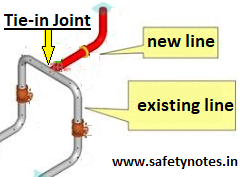
Tie-in Definition:
The process of connecting a new line or branch to existing line by means of cutting and welding new T shaped pipe spool with a valve on the hydrocarbon process line is called as a tie-in of pipelines.
Hazards of Tie-in:
1. Presence of combustible gases inside or outside of the pipe.
2. Fire and burn injuries.
3. Erection and shifting on heavy spool and valve.
4. Scaffolding collapse if working on height.
5. All hot work-related hazards.
Safety Procedure for Tie-in jobs:
1. Line isolation by putting blinds on flanges, line breaking and disconnecting from the process.
2. Approved blind list signed by the plant operator.
3. Risk assessment with the permit shall be taken and blind list number should be maintained on permit.
4. Initially line has to purge with steam or air, depending on type and size of the line for some time period for release of combustible gases from the pipe.
5. If required or line has not clear, nitrogen shall be used for purging as an inert gas.
6. Do the gas test using multi gas monitor to ensure LEL reading.
7. Once a line is clear start job with cold cutting.
8. Again check for LEL and if required insert plug or balloon inside the pipe to avoid any sudden gas flow from the pipe.
9. Take the hot work permit for hot work and follow all necessary hot work precautions for job.
10. Monitor the gas continuously.
11. Job supervisor and safety shall be available full time.
12. LEL value for cold work- 10% and for hot works- 1% preferably zero.

Worth to read! thanks for sharing, everyone will surely gain a knowledge from this! Keep posting an informative and helpful work like this. Btw, here’s also the office carpet cleaning service Singapore, you can visit and message our website offering services in affordable prices! thankyou!
I do not know whether it’s just me or if
everybody else experiencing issues with your site. It appears
as though some of the written text in your posts are
running off the screen. Can somebody else please provide feedback
and let me know if this is happening to them too? This may be
a issue with my web browser because I’ve had this happen before.
Many thanks
If you are going for best contents like myself, just visit this web page daily since it offers quality contents, thanks